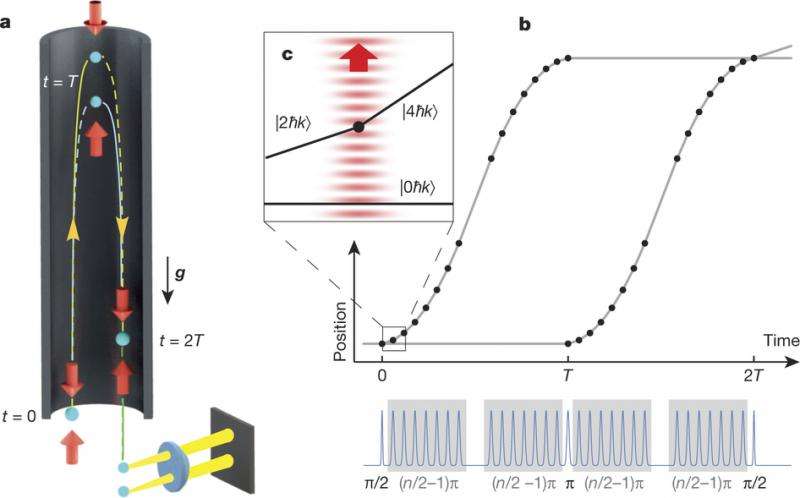December 29, 2015 report
New half-meter record for quantum superposition at macroscopic level

A team of researchers working at Stanford University has extended the record for quantum superposition at the macroscopic level from one to 54 centimeters. In their paper published in the journal Nature, the team describes the experiment they conducted, their results and also discuss what their findings might mean for researchers looking to find the cut-off point between superposition as it applies to macroscopic objects versus those that only exist at the quantum level. Nature has also published an editorial on the study, describing the experiment and summarizing the results.
Scientists entangling quantum particles and even whole atoms have been in the news a lot over the past couple of years, conducting experiments with the goal of attempting to better understand the strange phenomenon—and much has been learned. But as scientists figure out how to entangle two particles at ever-greater distances, there are questions about the size of objects that can be entangled. Schrödinger's cat has come up in several such discussions as theorists and those in the applied fields seek to determine if it might be possible to cause a whole cat to occupy two places at once. In this new work, the team at Stanford has, perhaps, muddied the water even more, as they have extended the record for supposition from a mere one centimeter to just over a half-meter.
They did it by creating a Bose-Einstein condensate cloud of 10,000 rubidium atoms inside of a super-chilled chamber, all initially in the same state. Next, the used lasers to push the cloud up into the 10-meter-high chamber, which also caused the atoms to enter one or the other of a given state. As the cloud reached the top of the chamber, the researchers noted that the wave function was a half-and-half mixture of the given states and represented positions that were 54 centimeters apart. When the cloud was allowed to fall back to the bottom of the chamber, the researchers confirmed that atoms appeared to have fallen from two different heights, proving that the cloud was held in a superposition state.
The team acknowledges that while their experiment has led to a new record for superposition at the macroscopic scale, it still was done with individual atoms; thus, it is unclear if superposition will work with macroscopic objects.
More information: T. Kovachy et al. Quantum superposition at the half-metre scale, Nature (2015). DOI: 10.1038/nature16155
Abstract
The quantum superposition principle allows massive particles to be delocalized over distant positions. Though quantum mechanics has proved adept at describing the microscopic world, quantum superposition runs counter to intuitive conceptions of reality and locality when extended to the macroscopic scale1, as exemplified by the thought experiment of Schrödinger's cat. Matter-wave interferometers, which split and recombine wave packets in order to observe interference, provide a way to probe the superposition principle on macroscopic scales4 and explore the transition to classical physics. In such experiments, large wave-packet separation is impeded by the need for long interaction times and large momentum beam splitters, which cause susceptibility to dephasing and decoherence1. Here we use light-pulse atom interferometry to realize quantum interference with wave packets separated by up to 54 centimetres on a timescale of 1 second. These results push quantum superposition into a new macroscopic regime, demonstrating that quantum superposition remains possible at the distances and timescales of everyday life. The sub-nanokelvin temperatures of the atoms and a compensation of transverse optical forces enable a large separation while maintaining an interference contrast of 28 per cent. In addition to testing the superposition principle in a new regime, large quantum superposition states are vital to exploring gravity with atom interferometers in greater detail. We anticipate that these states could be used to increase sensitivity in tests of the equivalence principle, measure the gravitational Aharonov–Bohm effect, and eventually detect gravitational waves and phase shifts associated with general relativity.
Journal information: Nature
© 2015 Phys.org




















